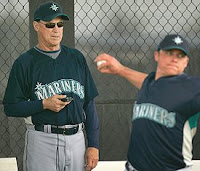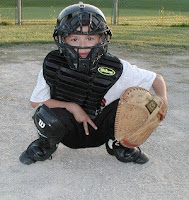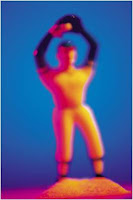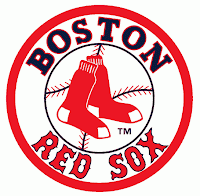Girlfriend, you want to know what my dream job would be?
One word: bobbleheads.
I want to give away bobbleheads.
As in Seattle Mariners Yuniesky Betancourt Bobbleheads Giveaway night. Or be the person who gives out Boston Red Sox Dustin Pedroira lunch boxes and baseball hats. Or that person who arranges for “Kids Run Around the Bases” night where all kids under twelve can storm the field after the Sunday afternoon game and run around the major league bases. Or the best promotional idea ever--Ichiro Suzuki headbands. A martial arts head bands complete with the Japanese Rising Sun. Free to the first 20,000 fans.
Or how about Miller Stadium in Milwaukee where they hold a seventh inning sausage race featuring a hot dog, a bratwurst and a Polish sausage race around the bases while the crowd cheers for the link they think will reach home plate first. When the Milwaukee Brewers hit a home run, Bernie Brewer the mascot (it used to be Bonnie Brewer) slides down a slide into a platform and balloons are released into the air. Back in the seventies, Bonnie, dressed as a Bavarian Bar Maid slid into a very large, distinct stein of beer, and the balloons represented carbonation. Talk about a Milwaukee crowd pleaser! We are more politically correct now.
My dream job is to work as a marketing person for the Seattle Mariners or any baseball team that would have me. Remember I’m the one who came up with the cafeteria tray with the team logo. That idea is looking better every day. Just recently a young boy was attending his first Major League Baseball game in Chicago and was seriously hurt when he got hit in the head with a baseball. Poor little guy! Cafeteria trays with your team logo. You heard it here first.
Seattle, give me a call. I got a million ideas. How about “Girlfriends Run Around the Bases” night with the catcher and pitcher of the home team greeting everyone at home plate with pitchers of margaritas and a customized salt-rimmed-margarita-glass adorned with the home team logo? The Boyfriend suggests having tours where you can stand at home plate in an at bat and feel what it is like for a Major League Pitcher to throw a fast ball down the middle of the plate. Brilliant!
You got to keep the crowd involved. You’ve got them to rally around the team. And you have to build a fan base. While some fans in Boston are trying to kick other pink hatted fans out of the ball park, I think the teams themselves welcome new fans and want to develop devoted fans. Let’s face it, if you really want to watch a ball game, you can probably follow it so much better on television. But that’s not really the point, is it? Baseball is supposed to be fun. Going to a baseball game is supposed to be fun, too. When you go to a live game, you want to watch the game, and share the experience with the other fans around you. You want to be there.
You want to walk up First Avenue in Seattle on a sunny, cool evening, stop at the Triangle Bar right before the park, have a cold Rainier and watch the river of fans stream by the outside beer garden, looking for fans wearing the baseball caps of the opposing team. Then you walk the rest of the short way into the park. And it doesn’t matter if you have been to Safeco Field before, it always takes your breath away when you see the field and you hear the trains’ blare in the background.
Or you want to take the Green Line into Boston and walk down Yawkey Way joining a growing jumble of people in red and blue (and a few in pink) in the narrow streets, stop and have some fried clams with bellies and then squeeze into the narrow aisles and sing along with Sweet Caroline at the seventh inning stretch and wave at the Citgo sign and make a joke about Dunkin' Donuts and swear you are not going to get seats behind a post next time.
Or, as The Softball Diva tells it, you take No. 4 train to Yankees Stadium and find your spot in the cavernous, soon-be-torn-down stadium, order a beverage from your favorite beer vendor, and yell out the roll call at the beginning of each game trying to get all the players of your beloved Yankees to acknowledge you.
That’s what makes live games so fun. That’s why I want to be the one who organizes Stitch and Pitch Night or Resusable Grocery Bag Night. I want to be the one who gets up and sings the Star Spangled Banner. I want to join the team that convinced the management to print up Marineros baseball caps for the crowd to acknowledge the Hispanic contribution to baseball. Or print up the terrible towels designed to distract and terrify the opposing team, or pass out the Rally Monkeys (whatever the hell those things are supposed to be.)
I know, the really diehard fans are booing and throwing tomatoes at me right now (right over the plate, buddy!) or throwing a cream pie in my face to make me leave the field. (Hey, wait, Washington cherry pie night... a pie throwing contest... throwing out the first pie of the evening… I think we got something here!) I know ballparks that sell out regularly like Fenway Park and Yankee Stadium don’t need this kind of hokum. But for me, this is the job of a lifetime. If you can’t play baseball, at least you can “play” baseball.
Meanwhile, if you are looking for a unique gift idea for someone, especially one who is a baseball fan, did you know that you can have your own custom made bobble head made that resembles that person? Check it out at:
http://www.whoopassenterprises.com/
http://www.headbobble.com/index.html
Really, I think this is a great idea! And I got a million more where that came from.








